In preparation for the My Future York Collaborative Hustings we’ve gathered together links to the four main parties political manifestos in one place. All have sections focused on transport and movement.
In alphabetical order:
Shaping the future through open conversations
In preparation for the My Future York Collaborative Hustings we’ve gathered together links to the four main parties political manifestos in one place. All have sections focused on transport and movement.
In alphabetical order:
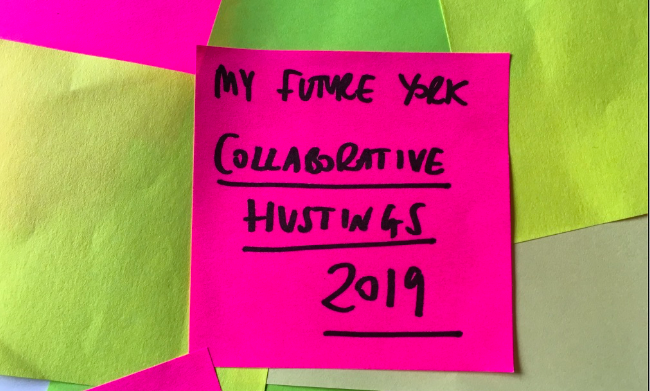
24th April 2019, 6-8pm
Spark York
Hustings are usually a combative affair. This local election season in York, can we create a more collaborative approach? Join us for the My Future York Collaborative Hustings.
In the My Future York Collaborative Hustings we plan to reframe hustings – or, in fact, tap into its more ancient meaning. While today ‘hustings’ immediately evokes a series of candidates making speeches and answering questions for an audience, its arcane use, from Old Norse, is ‘an assembly for deliberative purposes’.
For the 2019 Collaborative Hustings we have chosen a specific issue facing York: traffic congestion. While there are significant differences between political parties in how we might tackle traffic congestion, there is cross-party and wide spread public recognition that congestion is an urgent issue. It’s also an issue with only the vaguest of boundaries, touching on transport, urban planning, environmental issues and the nature of our city centre – it’s much broader than a single manifesto issue.
Traffic congestion is also an issue that cannot be fully understood or simply fixed top down by politicians. It is linked into everyday experiences, actions and choices made by all of us who live in York. It is, therefore, an issue that we need to address collaboratively.
We’ll start the hustings by collectively identifying the key issues which contribute to creating traffic congestion and then coming together to map out the issues, seeing how they might connect and identifying where the leverage points for change might be. We’ll then ask candidates from all parties to talk about how they might respond to these issues and leverage points and look for the commonalities in approach. We will then work together – councillors-to-be and citizens – to set out how all of us can contribute to putting a long term collective approach into practice.
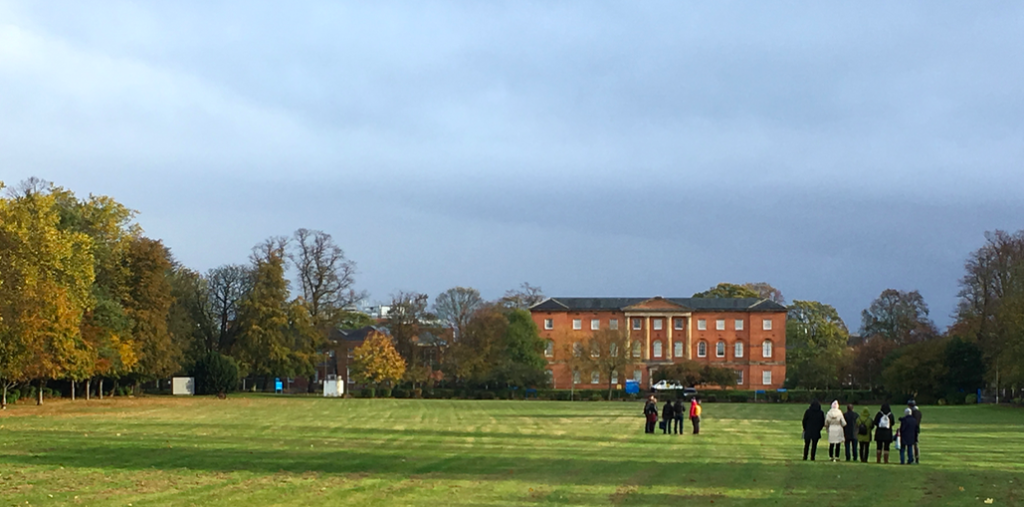
Read the Bootham Park Open Briefing Notes
My Future York have been involved with Bootham Park Hospital site by working with City of York Council and One Public Estate to develop a relatively brief public engagement programme. Our work is generally longer-term and embraces the establishment of an open conversation by building a brief, exploring the challenges which it throws up, and then making change together to ensure public/private investment is matched by community-led change and animation.
With Bootham Park Hospital, given the time constraints imposed by the pause in the disposal process, we have focussed upon building a community vision for the possibilities of the site – incomplete and in some areas conflicting – but bringing a context which reflects both lingering anger over the loss of Bootham Park as a hospital and the plans to sell the site as well as the many positive ideas that have been shared as part of the process.
We ran a one-day event on site on 27th October in partnership with Coaching York, and preceded this with networking and site visits with a number of groups and individuals who brought specific skills, understanding or agendas for change. We have also incorporated into our briefing notes below all input via post-its on the consultation exhibitions at York District Hospital, West Offices and the Citadel, plus those from other events such as the Save Bootham Park Hospital evening event and the Guildhall ward meeting. Furthermore, we have incorporated input given via the online questionnaire and social media.
We have used this information to identify the issues which were seen as important and to build links between them where this is helpful. This is not a vote – there is no attempt to count “for” and “against” comments in relation to any issues, but where there is strong feeling this is noted.
We published them here as a draft – reflections and further comments welcome. We’ll incoperate all comments we recieve before 6th December.
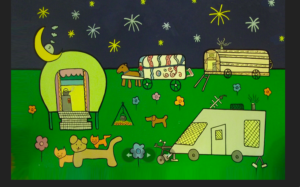
As part of the My Future York project, Helen Graham worked with York Travellers Trust and with, Carrieanne Eddison, Denise Lambert, Lorraine Mulvenna, Debi White, Christine Sheppard, Kally Smith and Kay Tate to develop these articles.
Gypsies and Travellers are widely recognised as a significant ethic and cultural group in York. The 2015 floods which affected James Street brought an enormous amount of solidarity and support for the gypsies and travellers who were forced off their site. As one of us, Kally Smith puts it, ‘the whole city came together’.
Yet changes to national legislation have the potential to negatively affect the future of York’s gypsy communities. In August 2015 planning guidance changed the definition of Gypsy and Traveller to remove the idea of a cultural identify, ‘persons with a cultural tradition of nomadism or living in a caravan’. Since the new policy came into effect, this has meant that to be recognised as a Gypsy or a Traveller for planning purposes you had to be only temporarily settled. This has had serious implications for planning for the communities’ future through the Local Plan.
With the Local Plan final public consultation now closed, through four short ‘in conversation’ articles, we explore different aspects of past, present and future life for York’s Gypsy and Traveller communities.
The national policy changes and its implications for the Local Plan has raised the question of how York – a Human Rights City – can be proactive in enabling the city’s Gypsy and Traveller communities to be fully recognised as a cultural group. It also prompts us to ask some broader questions: How can we ensure all of the city’s communities and their ways of life are planned into the city’s future? How can the way we understand the city’s heritage to be expanded beyond our buildings and archaeology to include living culture and ways of life?
You can read the four different conversations here:
Floods 2015: ‘the whole city came together’
The Local Plan, culture and community
You can also read Violet Cannon (Chief Officer, York Travellers Trust) imagined future for York Central, ‘Sharing York’s Gypsy Traveller Heritage’
My Future York has been asking people about an ideal day in their lives in 10 years time to build bottom up a vison for the future of the city – here we explore summer days on the road and possibilities of co-operatively owning and running sites.
Lorraine: I like having a base, if I was a wealthy person I’d have a base but I’m not so we’re on a council site. But I like to go away. We’ve got horses and a wagon. They can’t stop you. What they do now is put stakes at Appleby time, on the main road sides. Or they’ll cut the grass verges so there’s no grazing. We need more sites with 15 + slabs to enable communities to live together and so it’s not lonely.
Lorraine: In ten years’ time I’d like the children, with grandchildren, to be anywhere on the James Street site. I’d like to use stopping places in the summer months. It would be nice if you could go to sites with grass and with an electric box to plug into. Ideally there would be a transit site in every town. Once upon a time in my mam and dad’s days there was common land wherever you went. You might want to spend the summer somewhere on the road sides. There would have to be an infrastructure for your rubbish.
Kally: You won’t want to go and leave your site just to go to another transit site. It’s more about travelling up and down the roads and pulling on the roadside. Five years ago we travelled, we went to Bridlington, big playfields near the swimming baths and spent two weeks there. It brought it all back. That had been our life.
Helen: Imagine that it is the summer…
Lorraine: I might go down to Cornwall to a transit site there. In the ten years’ time I’d want to be back to the site for the winter. On James Street, the site has been raised up, with bigger sheds and everything is pleasant. They’ve also extended us a bit, we could be up to the hedge and the beck.
Kally: On James Street in ten year’s time, there is no-one on top of one another, there are larger fences for a bit more privacy.
Lorraine: In ten years time, the Council are still running James Street, because the Council are better off owning Gypsy sites than privately-owned because if sites are privately owned we end up with a dog’s life. Owning the site ourselves might also be an option. If I own my little patch. Everyone owns their own plot, if you want to.
Kally: I want to be on the James Street site with the same families, so that the children can take over the family slab. We’d like to be able to pass the slabs on, we’d like to have control over that.
York has become a Human Rights City. This means positively celebrating and enable flourishing of all York communities. If you’d like to support York’s Gypsy and Traveller communities, join the Human Right’s City pledge.
Read other people’s ideas for the future of the city and contribute your own on myfutureyork.org / myyorkcentral.org / mycastlegateway.org
Earlier in the year the City of York Council asked for final responses to the Local Plan. The Local Plan sets the vision for planning and accommodation needs for the coming decades. In August 2015 the planning guidance changed the definition of Gypsy / Traveller to remove the idea of a cultural identity, ‘persons with a cultural tradition of nomadism or living in a caravan’. Since the new policy came into effect, this has meant that to be recognised as a Gypsy or a Traveller for planning purposes you have to show you are only temporarily settled. The local implications of that is that the projected need for new Gypsy and Traveller pitches has dropped: how can York ensure it is properly planning for the future of one of the city’s most significant communities?.
Carrieanne: In 10 year’s time we’ll all be in houses, the Council’s trying to get rid of the sites. Younger generations will have no more option. If there were more sites available, they would be on them.
Denise: We need another 50 pitches, at least, because there are people who are in houses because there is nowhere else and people who have double up on space. It causes a lot of depression when people end up in houses, they feel isolated. Once you shut the door you see no one. On a site people are popping in all the time. If they are off to the shop, they’ll pop in and see you. In houses, you don’t see nobody. It’s a lonely life when you go into a house.
Lorraine: If we did agree to move into houses, they’d only offer one or two houses and not a whole street because they don’t understand the kind of community we are. When Travellers buy a house they still have all their relatives pulled up behind them because we have to have our own around us.
Kally: My daughter might want a slab on James Street, but I know she won’t be getting one. The council haven’t planned for this.
Lorraine: Gypsy is our culture. A lot of them are coming to realise that calling us Travellers [as in the planning policy] is our undoing. Some will want to live our way of live. Some will move into houses. But that doesn’t mean they aren’t Gypsy people. You can breed it out but you can’t take it out. That’s where you are coming from, that’s your heritage. Whoever is deciding this thing, that you have to travel in order to be a Gypsy, shows to me that the term Traveller should be dropped, we should clam our cultural identity and call ourselves Gypsies.
Christine: Since they changed the definition of Gypsy Traveller, it’s gone from 66 to 3 pitches [under planning guidance]. But people are in a Catch 22. To get housing benefit, you can’t be away for more than six weeks but you have to be away for eight weeks to be counted as a Traveller.
Lorraine: The way we still want to be able to live is simply to live the way all everyone lived 40-50 years ago. They had street parties and they were in and out of each other’s houses. It’s your society that’s lost this way of living, not us. If you go to other countries, normal people in other country they have a community, our English society has lost that. Here everyone’s an island, they don’t even bother with their own. Mainstream society should be taking a leaf out of our book.
The final version of the Local Plan raised a number of issues for York’s Gypsy and Traveller Community and York Traveller’s Trust have been addressing the issues with the City of York Council. With the changes in planning guidance, the number of pitches went from 66 to 3. York Traveller’s Trust believes from their research that this is an underestimate and will be advising a revised figure. The Trust welcomes that City of York has also used equalities legislation to identify an addition 44 pitches. The delivery of these 44 pitches is linked to developer duty based on scale of housing development, as is noted in the final version of the Local Plan. To make this a viable strategy York Traveller’s Trust believes the City of York Council must identify land for future pitches. We will be continuing this conversation as part of the wider public discussion through My York Central.
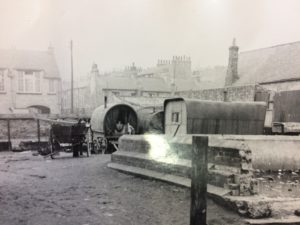
York’s Gypsy communities used to travel around the city to different areas, known as stopping places. Changes in the law and the increased speed of eviction notices has made this traditional way of life harder – but are there creative ways of planning for traditions of transit in the future?
Lorraine: The first time I remember staying in York, pulling into different places, was with me Mam and Dad. I’d be about nine or ten. We were always very clean. My mam would even sweep the fire and put some earth on top. Before we went onto James Street we used to stop on Poppleton Lane where the garden centre is now. Challaces, it used to be called. We also used to stop on Bad Bargain, Clifton Backies and we used to stop where Tesco’s now is. It wasn’t Tesco’s then it was just the aerodrome. From one area of the town to the other, but just on the edges where it was countrified.
Kally: What happened is they built James Street and it ruined the Travellers. We’d have been better on what we called the Tip. Even after we’d moved on the James Street, we’d still duck up on Back Bargain fields. We had a better lifestyle, we were much healthier and much happier. None of these problems with the Council on your back. Because on the Tip they never evicted you off, Sugar Beet they never evicted you off. They were the two main stopping points.
Lorraine: All the way up to Jewson was common land. We used to stop on common land, we’d stop on car parks. We were on there we were on the tip — it was common land. James Street, was just a tip. They never really came after you on the Gas Works Car Park either.
Kally: They didn’t have any plans for it.
Lorraine: But as soon as plans start going…
Kally: …we’d have started getting eviction notices.
Lorraine: In time we would.
Kally: I remember we pulled on the Clifton Backies and we stopped, we got evicted and they took us to court. They came a took us off and you know where they took us, to Malton Road that café, they moved us there, they towed us away to Malton Road.
Christine: They must have taken you into Rydale local authority area as it was.
Lorraine: So they took you from one area to another Council’s area, ‘so that was their problem then’
Debi: How long were you there for?
Kally: Not long because we moved back into York.
Lorraine: They’d done a court order and they evicted you, but then you came back and it was then another six week’s process to get you out.
Kally: So we moved somewhere else in York. They moved us on, we stopped overnight, then went back to the York, the Tip after that. The Tip was always there but you’d get bored. People would just get bored so we would maybe go to Bad Bargain and then it was back to the Terrace car park.
Lorraine: You’d be lucky if eviction takes 24 hours today. There were Christmas time camps, any holiday time we waited until it was all clear and then all pull on, even if you had to wait until 8pm at night. If you went on just before Christmas you’d know that they wouldn’t come after you until after new year. The law changed that was why we all put our names down to stay on James Street. We did a big campaign but they said we wouldn’t be allowed to stop up and down. So those that live around this town, we all put our names down for the sites.
Being able to travel for work or to attend dances and fairs was a traditional part of Gypsy life which has been made harder in recent years. Yet there are creative possibilities from transit sites which enable short stays through to negotiated stopping, as they do in Leeds, where the Local Authority works with Gypsy families and local resident to broker short term agreements.
In the Local Plan there is a provision protecting York’s historic environment. But can we also start to see different ways of life and traditions – as part of the city’s heritage?
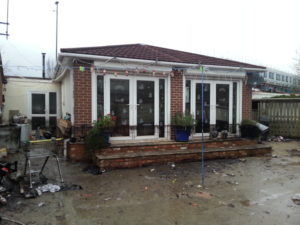
On Boxing Day 2015 York experienced the worst floods since 2000. When the Foss Barrier failed an area very badly affected was James Street, the home to one of the city’s Gypsy and Traveller Sites. Many people and businesses showed enormous support for those that were affected and for a time ‘the whole city came together’.
Kally: On Boxing Day the water just come up through the drains, like it does often do. We thought, ‘nah, it won’t get that bad’. We didn’t know what was going on around us. There is a man on the site who has a house phone and around 1am, he had a phone call and shouted out to us all, ‘get off the camp because it’s going to flood’. That night we just sat out the front of the site.
Denise: The next day people we know started to help. There was a man we knew in the houses near James Street called Alan, who has a boat. He is my daughter’s best friend’s father. He came round in his boat. He stayed all day until it dropped dark, going backwards and forwards, getting things for people out of the site.
Kally: There was also an old man and woman from the nearby houses who fetched teas for us.
Denise: Morrisons were really good. They said we could go in and get some things for the kids like PJ’s, underwear, socks and shoes. They also brought out bags of shopping for us.
Morrisons also said ‘go to the café and get a warm meal’. Nestles was good as well, they sent chocolate and coffee. The Catholic Traveller’s Group donated funds to Dunelm for us to get bedding. Joe Windas did some fundraising via facebook and organised two fundraising nights.
Kay: Someone at the York Traveller’s Trust offices went out for Fish and Chips and came back with mounds and mounds of fish and chips. People were sending hot sandwiches in to us too.
Kally: When people were walking past the site, they’d stop and say, do you need help? The full city came together, for a while.
Helen: What happen after the floods and during the clear up? Where were you living?
Kally: I was living in Malton. I was in a dark and lonely place in Malton, I was still with my child but not with my family or the community. I was thinking, am I going to get a home to James Street or am I going to be struggling to put something together? The Two Ridings charity gave money, if it wasn’t for them and their support to get the chalet sorted out, I’d still be struggling.
Helen: Given the flooding, do you thinking James Street worth fighting for?
Lorraine: Yes, as a camp and a community it is worth fighting for. It is probably the best situated camp in England, Scotland, Wales and Ireland too. You don’t need a car, you can walk everywhere, bus routes, schools over road, schools up the road. But the situation it is now, unless they improve the drains or heighten us up, that we are left with the threat of being flooded, we are living with that over our heads all the time.
York Traveller’s Trust thanks everyone that donated or helped out during the aftermath of 2015 flood. See the website if you’d like to support York Traveller’s Trust in their work on future flood prevention.
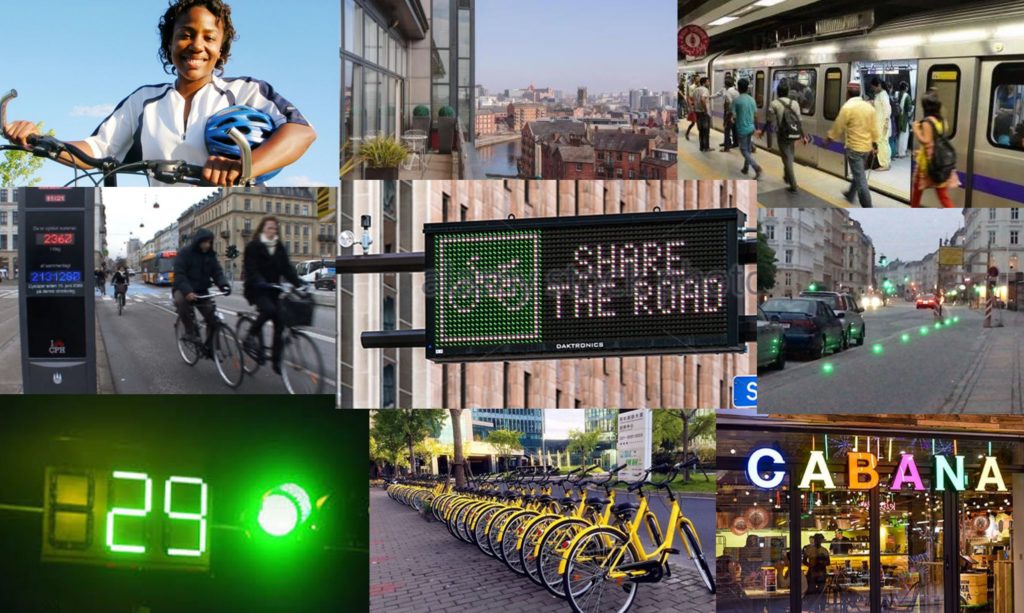
Paul Osborne, local transport planner, used the Festival of Ideas event on Re-imagining The City to paint a picture of a future journey.
Let me take you on a journey into the future. How far into the future is up to you…
I leave my 4th floor apartment in Moortown, Leeds. It’s eight o clock and overcast. I’m a bit late but hey, it’s not often England make the world cup final, two tournaments in a row.
My phone alerts me – my train is leaving on time and there’s a city bike waiting for me at the end of the street. As I approach, the bike unlocks itself and my phone pings to tell me that it has been serviced and the tyre pressures are fine.
I set off, humming a tune from the morning’s breakfast show. I pass the kids making their way to school, some of them wearing their replica England shirts. The bins are out for collection. The pothole which had opened up the day before, has been fixed.
The car ahead, automatically limited to 20mph on all residential streets in the city, moves to the right to let me through, the driver alerted to adjust his position by his in-car sensors. I thank him as I go by and his daughter smiles at me through the car window.
At the next junction I have a left turn towards the city centre, I wait for a gap in the steady flow of inbound cyclists, safely separated from traffic. I join them and soon we are travelling at a steady 12 mph, nudged along by the coloured LED lighting in the roadway, sequenced to progress us through the next three sets of traffic signals.
We ride the green wave until we reach the first busy intersection. Countdown signals tell me how long we’ll be waiting, time enough to break into conversation with the cyclist next to me. She smiles and recommends a restaurant down a local side road – it does great vegetarian pizza.
The lights change, she’s quicker away than me. We pass the cycle counter which detects us as we pass, flashing up the daily and annual cycle flow. It feels good to be part of a crowd.
One hundred metres later (oops I mean yards – I’m still getting used to our return to imperial measures) and a variable message sign thanks me for not using the car. It flashes up the predicted journey time to the city centre, currently 30% faster than the vehicle flow beside me.
We reach the Sheepscar interchange. Plans are afoot to bury this huge junction below ground level and leave buses, bikes and pedestrians to take the surface route. In the meantime, images of live CCTV footage are projected onto huge LED screens to enforce the new bus and cyclist priority measures, funded by the city’s health investment strategy.
There’s one short hill into the city centre but the electric assist on the bike kicks in, keeping my speed and effort consistent. I join another green wave, having covered my five mile mile journey to the station in just under 25 minutes.
My bike locks itself as I leave it in the bike park. My phone logs the distance I’ve covered and updates my reward points. I get the choice to top up my integrated public transport pass or spend it at my neighbourhood shops. The bike downloads information about the journey, alerting the bike share company to its location, and passes data about air quality, traffic conditions and road surface condition along my route to the city’s transport team.
I head for the train, flashing my Owl Card (the Leeds equivalent of Oyster), I find a seat and decide on a good night to try out that pizza.
As Paul noted afterwards, many of the “futuristic” ideas in that story are already reality somewhere in the cycling-friendly world. If you spot a link to one of them on the net, tweet us at @my_futureyork and tell us where it’s already happening!

On 17th June, My Future York participated in the University of York’s Festival of Idea. We ran some post it note discussions (all post its can be perused here) and did a talk as part of the final panel on Re-imagining York. You can read the talk here.